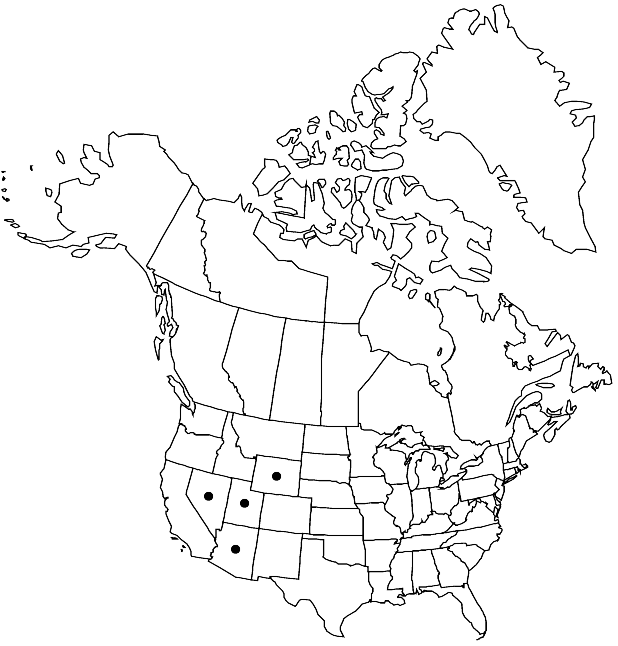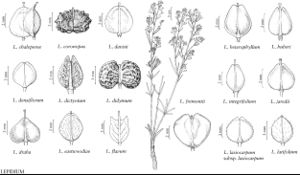Difference between revisions of "Lepidium integrifolium"
in J. Torrey and A. Gray, Fl. N. Amer. 1: 116. 1838.
FNA>Volume Importer |
imported>Volume Importer |
||
| (6 intermediate revisions by 2 users not shown) | |||
| Line 1: | Line 1: | ||
{{Treatment/ID | {{Treatment/ID | ||
|accepted_name=Lepidium integrifolium | |accepted_name=Lepidium integrifolium | ||
| − | |accepted_authority=Nuttall | + | |accepted_authority=Nuttall |
|publications={{Treatment/Publication | |publications={{Treatment/Publication | ||
|title=in J. Torrey and A. Gray, Fl. N. Amer. | |title=in J. Torrey and A. Gray, Fl. N. Amer. | ||
| Line 11: | Line 11: | ||
|name=Lepidium montanum subsp. integrifolium | |name=Lepidium montanum subsp. integrifolium | ||
|authority=(Nuttall) C. L. Hitchcock | |authority=(Nuttall) C. L. Hitchcock | ||
| − | }}{{Treatment/ID/Synonym | + | |rank=subspecies |
| + | }} {{Treatment/ID/Synonym | ||
|name=Lepidium montanum var. integrifolium | |name=Lepidium montanum var. integrifolium | ||
|authority=(Nuttall) C. L. Hitchcock | |authority=(Nuttall) C. L. Hitchcock | ||
| − | }}{{Treatment/ID/Synonym | + | |rank=variety |
| + | }} {{Treatment/ID/Synonym | ||
|name=Lepidium utahense | |name=Lepidium utahense | ||
|authority=A. Nelson | |authority=A. Nelson | ||
| − | }}{{Treatment/ID/Synonym | + | |rank=species |
| + | }} {{Treatment/ID/Synonym | ||
|name=Lepidium zionis | |name=Lepidium zionis | ||
|authority=(Nuttall) Kuntze | |authority=(Nuttall) Kuntze | ||
| − | }}{{Treatment/ID/Synonym | + | |rank=species |
| + | }} {{Treatment/ID/Synonym | ||
|name=Nasturtium integrifolium | |name=Nasturtium integrifolium | ||
| − | |authority= | + | |authority= |
| + | |rank=species | ||
}} | }} | ||
|hierarchy=Brassicaceae;Brassicaceae tribe Lepidieae;Lepidium;Lepidium integrifolium | |hierarchy=Brassicaceae;Brassicaceae tribe Lepidieae;Lepidium;Lepidium integrifolium | ||
| Line 39: | Line 44: | ||
|distribution=Ariz.;Nev.;Utah;Wyo. | |distribution=Ariz.;Nev.;Utah;Wyo. | ||
|discussion=<p>Of conservation concern.</p><!-- | |discussion=<p>Of conservation concern.</p><!-- | ||
| − | --><p>The circumscription of Lepidium integrifolium is somewhat controversial. C. L. Hitchcock (1936) treated it as two varieties or (Hitchcock 1950) two subspecies of L. montanum, whereas R. C. Rollins (1993) treated it as a distinct species with two varieties. Rollins indicated that the species has two stamens, but such occurrence is rather rare. Most commonly, it has four stamens and is readily distinguished from related species by having four nectar glands and sepals sparsely pubescent subapically with crisped trichomes. Nothing is known about the populational variation of stamen number in the species and whether one or more taxa are involved.</p> | + | --><p>The circumscription of <i>Lepidium integrifolium</i> is somewhat controversial. C. L. Hitchcock (1936) treated it as two varieties or (Hitchcock 1950) two subspecies of <i>L. montanum</i>, whereas R. C. Rollins (1993) treated it as a distinct species with two varieties. Rollins indicated that the species has two stamens, but such occurrence is rather rare. Most commonly, it has four stamens and is readily distinguished from related species by having four nectar glands and sepals sparsely pubescent subapically with crisped trichomes. Nothing is known about the populational variation of stamen number in the species and whether one or more taxa are involved.</p> |
|tables= | |tables= | ||
|references= | |references= | ||
| Line 48: | Line 53: | ||
-->{{#Taxon: | -->{{#Taxon: | ||
name=Lepidium integrifolium | name=Lepidium integrifolium | ||
| − | + | |authority=Nuttall | |
| − | |authority=Nuttall | ||
|rank=species | |rank=species | ||
|parent rank=genus | |parent rank=genus | ||
| Line 63: | Line 67: | ||
|publication year=1838 | |publication year=1838 | ||
|special status= | |special status= | ||
| − | |source xml=https:// | + | |source xml=https://bitbucket.org/aafc-mbb/fna-data-curation/src/2e0870ddd59836b60bcf96646a41e87ea5a5943a/coarse_grained_fna_xml/V7/V7_942.xml |
|tribe=Brassicaceae tribe Lepidieae | |tribe=Brassicaceae tribe Lepidieae | ||
|genus=Lepidium | |genus=Lepidium | ||
Latest revision as of 22:37, 5 November 2020
Perennials; (caudex often thick, not aboveground, covered with persistent petiolar remains); puberulent. Stems several from base (caudex), ascending, branched distally, (1–)1.5–3.5(–4) dm. Basal leaves rosulate; petiole (0.5–)1.5–6(–7.5) cm; blade oblanceolate to obovate, (1.5–)2.5–7(–9) cm × (10–)15–25 mm, margins usually entire, rarely denticulate subapically. Cauline leaves shortly petiolate or sessile; blade narrowly lanceolate to broadly oblanceolate, 1–5 cm × 2–9(–12) mm, base cuneate, not auriculate, margins usually entire, rarely denticulate subapically. Racemes elongated in fruit; rachis puberulent, trichomes straight, sometimes clavate. Fruiting pedicels divaricate-ascending to horizontal, straight, (not winged), (4–)5–10 × 0.3–0.5 mm, puberulent adaxially. Flowers: sepals oblong-obovate, (1.5–)1.8–2.5 × 0.8–1.3 mm; petals white, obovate, (2.3)2.5–3.6(–4) × 1.5–2.2 mm, claw 0.5–1 mm; stamens (2 or) 4 (or 6), median and lateral when 4, (erect); filaments 1.7–2.5 mm, (glabrous); anthers 0.5–0.8 mm. Fruits ovate, (3–)3.2–4(–4.4) × 2–3.5 mm, apically winged, apical notch 0.1–0.3 mm deep; valves thin, smooth, not veined, glabrous; style 0.5–0.8(–1) mm, exserted beyond apical notch. Seeds ovate, 1.8–2 × 0.9–1.1 mm.
Phenology: Flowering Jun–Jul.
Habitat: Alkaline and saline meadows
Elevation: 1300-2000 m
Distribution

Ariz., Nev., Utah, Wyo.
Discussion
Of conservation concern.
The circumscription of Lepidium integrifolium is somewhat controversial. C. L. Hitchcock (1936) treated it as two varieties or (Hitchcock 1950) two subspecies of L. montanum, whereas R. C. Rollins (1993) treated it as a distinct species with two varieties. Rollins indicated that the species has two stamens, but such occurrence is rather rare. Most commonly, it has four stamens and is readily distinguished from related species by having four nectar glands and sepals sparsely pubescent subapically with crisped trichomes. Nothing is known about the populational variation of stamen number in the species and whether one or more taxa are involved.
Selected References
None.
